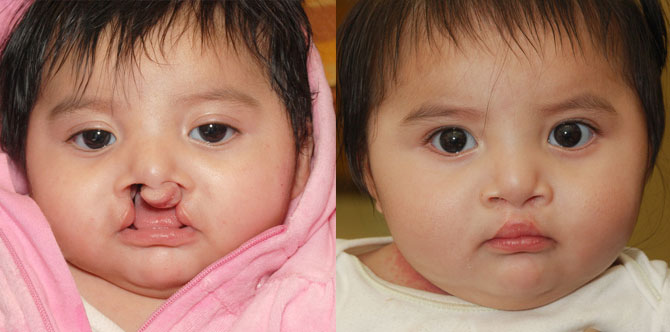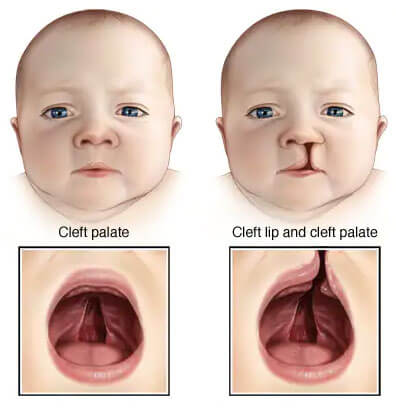Cleft Lip and Cleft Palate
Cleft lip and cleft palate usually occur during the early months of fetal development and are congenital conditions. After birth, it usually manifests in a way that the corners of the lip and the roof of the mouth have not fused properly.
Cleft lip is an abnormality in which the lip does not fully form during fetal development. Clefts can be unilateral, complete, or bilateral. Sometimes, cleft lip and cleft palate are seen together.


Cleft Lip
Cleft lip can be a small gap or a large gap that extends towards the nose, causing a change in the shape of the nose as well. A child may have cleft lip, cleft palate, or both simultaneously. Cleft lip and cleft palate are more commonly observed in boys. Sometimes, the treatment process for these patients requires the engagement of a large group of specialists. Sometimes, the visit, treatment plan, and surgical treatment of cleft palate or cleft lip can only be performed by a maxillofacial surgeon. However, sometimes it is necessary to meet with the following team and factors for treatment planning or treatment alongside each other.
Maxillofacial surgeon, plastic surgeon, otolaryngologist, pediatrician, orthodontist, cosmetic and restorative dentistry specialist, speech therapy, and counseling… form the medical team to assist the patient in improving cleft palate or cleft lip.
Cleft Palate
Cleft palate occurs when the roof of the mouth does not fully close, leaving a gap that can continue into the nasal passage.
The cleft can occur on either side of the roof of the mouth. It can extend from the front of the mouth (hard palate) to the back of the throat (soft palate). It is usually rooted in genetic and hereditary factors.
This cleft may be present in the alveolar region or the location of tooth eruption, which may lead to future problems such as abnormalities in tooth eruption because the bone is absent in a certain area of tooth eruption.

Treatment of Cleft Lip and Cleft Palate
Dear patients with cleft lip and cleft palate who require bone grafting from the hip in the jaw area can contact us to schedule a visit with a maxillofacial surgeon. These individuals often require this procedure during orthodontic treatments as well.
Lorem ipsum dolor sit amet, consectetur adipiscing elit. Ut elit tellus, luctus nec ullamcorper mattis, pulvinar dapibus leo.
- Saturdays: 14:00 to 20:00 - Punak clinic
- Sundays: 14:00 to 20:00 - Shariati clinic
- Mondays: 14:00 to 20:00 - Punak clinic
- Thursday: 14:00 to 20:00 - Saveh clinic
Frequently Asked Questions about Cleft Lip and Cleft Palate
The exact cause of cleft lip and cleft palate is not fully understood. The influence of genetic factors is the primary focus in this condition.
When a combination of genes and environmental factors leads to a certain condition, the term "multifactorial inheritance" is used, indicating the involvement of multiple factors.
It is important for mothers to notice a few points such as not smoking and avoiding alcohol use. Additionally, the use of certain medications such as anti-seizure or anti-cancer drugs by parents sometimes contributes to the development of cleft lip or palate in their children.
Mothers who use methotrexate (anticancer drugs) also have an increased risk of having infants with cleft palate or lip. Those with a folic acid deficiency have a higher chance of their children experiencing this condition as well.
The symptoms of this anomaly are usually visually evident. However, they can be diagnosed during the initial examination by a pediatrician.
Although the severity of this anomaly may vary among children or worsen during infancy, a surgeon or pediatric specialist can identify the abnormality by examining the mouth and lips as an incomplete obstruction in the lip, palate, or both.
The symptoms of this anomaly are usually visually evident. However, they can be diagnosed during the initial examination by a pediatrician.
Although the severity of this anomaly may vary among children or worsen during infancy, a surgeon or pediatric specialist can identify the abnormality by examining the mouth and lips as an incomplete obstruction in the lip, palate, or both.
The first point to note is that the treatment for this type of patient is carried out through teamwork. Due to the impact on the health and function of various parts of the jaw, face, and body, it needs to be evaluated and treated by an experienced specialized team.
The presence of a psychologist or psychiatrist alongside parents or the child in the future is crucial. Additionally, the involvement of a maxillofacial surgeon, otolaryngologist, dentist, nutritionist, and, in the future, speech therapist is necessary.
It is noteworthy that these patients may either have cleft lip or palate at birth or have syndromic diseases or other underlying problems such as congenital heart defects. In such cases, other diseases need to be examined and controlled as well.
Scientifically, from the past to the present, surgery for cleft lip or palate usually begins with the first surgery and treatment at around ten months of age, and the treatment starts with lip surgery. Typically, until around 18 months of age, hard palate treatment and reconstruction stages are performed, and before the age of 7 or before starting school, soft palate correction is done to improve speech and communication. However, nowadays, in most cases, both soft and hard palate surgeries are performed simultaneously, and then, with the eruption of the canine tooth in the upper jaw, the focus shifts to bone grafting in the cleft palate area, and bone graft surgeries are performed for repair and reconstruction. This treatment is usually done around the age of 9.
In adolescence or youth, some of these patients show upper jaw abnormalities such as Class 3 malocclusion. This is because the maxilla growth process is not fully completed and developed due to the cleft palate, resulting in the upper jaw being underdeveloped and the lower jaw protruding. In the final stages of growth, around 17-18 years of age, the patient becomes eligible for orthognathic surgery, which includes jaw surgery and orthodontics. Rhinoplasty is also performed, if necessary.
It is worth noting that rhinoplasty or nose surgery, if needed, is one of the final stages of treatment for these patients. If nasal surgery is performed, a secondary lip repair surgery may also be performed if necessary.